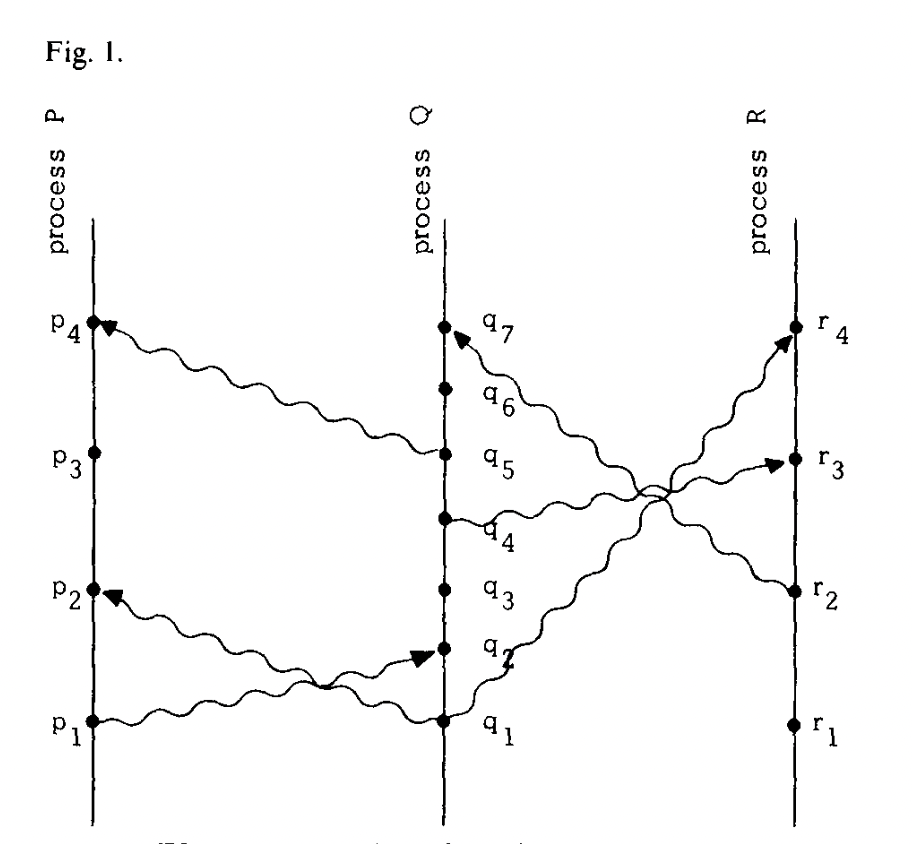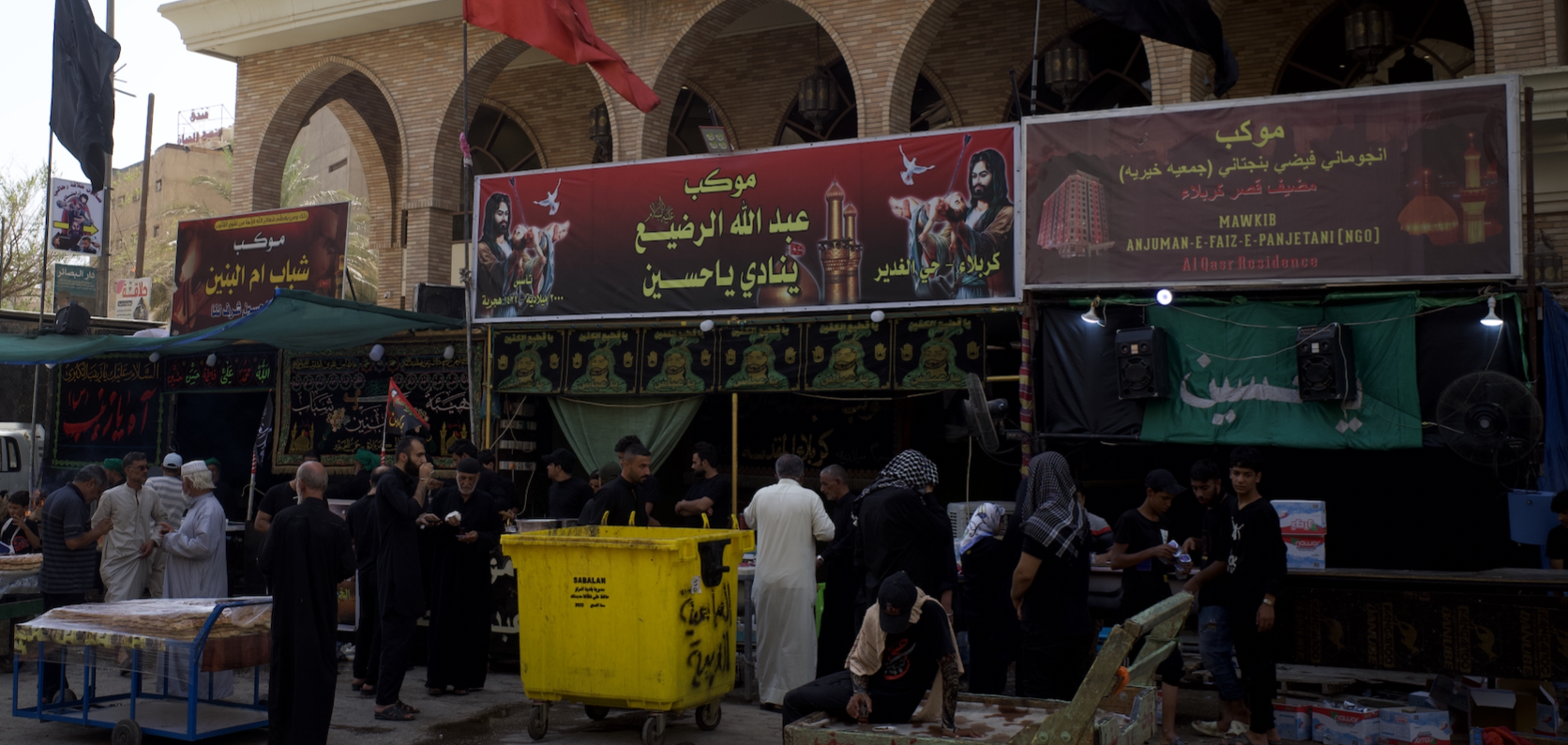Time as the Ur-text of Behavior: Pilgrimage, Distributed Systems, and Money
Table of Contents
Midjourney generation of
pilgrimage across ocreans, shrines dedicated to time, genealogies of pilgrims across the indian ocean with ships.
Time is money, money is time. Anthropologists love talking about time, especially our conceptualizations of it. I study Karbala, a Shia holy city, and the entirety of the pilgrimage revolves around a new conceptualization of time. Academics debate how time relates to pilgrimage, and Shia rituals, through the medium of tragedy, reenact the Battle of Karbala in 680 AD. Funnily enough, the other side of me works heavily in distributed systems and money, which is yet another part of the world that deals heavily with time.
All three systems (pilgrimage, distributed systems, and money) are all premised around two entwined concepts: time and consistency. I'm going to make the argument that because time and consistency are so interrelated, we can use the tools provided by distributed systems research and monetary behavioral research to read into pilgrimage. Consistency is created through labor acting upon a time, but the creation of consistency requires creating a man-made informational realm, which in turn informs social behavior. This requires a few leaps of faith, so let's build from the beginning: tokens and ordering.
1. Tokens
Tokens are physical things we define that can be exchanged for value. A dollar bill, a gold doubloon, a shiny rock, etc, let's define to be tokens. Tokens, by existing in the physical world, cannot be replicated without some effort: you need to dig up a new doubloon and print a new bill, which limits their reach. Once exchanged, you cannot simply cause a new token to appear in existence. If you spend a shiny rock, new shiny rocks do not magically appear in your pocket: you need to go perform some amount of labor (digging up new shiny rocks) to acquire another token. However, at a certain point, tokens become cumbersome due to their physical nature: you can't walk around with 10,000 shiny rocks all the time. As a result, ledgers become necessary.
Ledgers, however, exist purely in the informational realm. Ledgers record how much of specific tokens one possesses. The difference is ledgers and tokens is that you can simply make up money on a ledger, or add more zeros, in the case of central bank printing money. This man-made informational realm is subject to manipulation: we all are aware of the Enron accounting scandals, bank fraud, and all sorts of similar problems. In the monetary system, central banks solve this with centralization: there is one large ledger that tracks a monetary system1.
2. Consistency
But what is centralization doing? Centralization is simply the labor of creating consistency. Consistency matters in money because it lies at the heart of the double spend problem: if everyone could print fake bills, we'd end up with massive inflation. For online purchases, it would be massively problematic if you could go to two merchants and spend the same 10 dollars.
Consistency has implications for society as well. Hadrami merchants, who departed from Hadramout in Yemen to build a merchant empire across the Indian Ocean, built it because they were able to bypass the diverse set of social customs and laws across the ocean. They did this through genealogy, or the assurance that a familial tie, built upon time, could provide a stable foundation for trade across disparate systems. Enseng Ho writes2:
Those genealogies have two important dimensions: while they enable the tracing of origins, they also allow communities of diverse origins to articulate with each other in new relations of mutuality and moral engagement, such as in shared family and shared religion. This duality involves cohabitation of closed and open aspects, or, in the more specific terms of kinship, of patrilineal and matrilateral ties.
Time and labor produce genealogy. The Hadrami merchants were helped along by their specific social customs of marriage: male descendants of the prophet were only allowed to marry other descendants of the prophet. In this practice, Hadrami merchants transformed time into a literal monetary value and built an empire. The Hadramis are not unique in this, the modern Bamboo network is a similar system. This was observed far earlier by Harold Ingrams, who states3:
It appears, in the East, that when you do not have Jews you have Hadhramis or Chinese and all are alike in their exclusiveness.
This "exclusiveness" is just the opposite view of consistency. What is exclusive for the outgroup is consistent for the ingroup, and all three mercantile groups have parlayed their consistency into money. In other words, genealogy is just a specific type of cultural consistency, and time and specific cultural labor produce genealogy, which in turn creates a sort of "cultural capital" that can be loosely liquidated into actual money later. Concepts of wasta4 and guanxi5 follow this.
3. History 1, History 2, and Distributed Systems
In the case of genealogy, we've only discussed a single time: human time. However, the concept of labor applied to time is hardly new: Dipesh Chakrabarty talks about History 1 and History 26, where the conception of historical time as an empty, godless, and uniform hamstrings the way Indians and third world historians write about their history. Geologic time runs on a different time scale than humans and railway time functions to align industry, and not everything must stem from a singular conceptualization of time, as Chakrabarty tells us.
Yet we hardly need to reach into post-colonial studies for various conceptualizations of time: Leslie Lamport has already done that for us in his seminal paper Time, Clocks, and the Ordering of Events in a Distributed System. As Lamport tells us:
The concept of time is fundamental to our way of thinking. It is derived from the more basic concept of the order in which events occur. We say that something happened at 3:15 if it occurred after our clock read 3:15 and before it read 3:16. The concept of the temporal ordering of events pervades our thinking about systems. For example, in an airline reservation system, we specify that a request for a reservation should be granted if it is made before the flight is filled. However, we will see that this concept must be carefully reexamined when considering events in a distributed system.
A distributed system consists of a collection of distinct processes which are spatially separated, and which communicate with one another by exchanging messages. A network of interconnected computers, such as the ARPA net, is a distributed system. A single computer can also be viewed as a distributed system in which the central control unit, the memory units, and the input-output channels are separate processes. A system is distributed if the message transmission delay is not negligible compared to the time between events in a single process.
…
In a distributed system, it is sometimes impossible to say that one of two events occurred first. The relation "happened before" is therefore only a partial ordering of the events in the system. We have found that problems often arise because people are not fully aware of this fact and its implications.
What are the conditions that Lamport refers to? It is the idea of casual ordering, the idea that we need to define specific events happening before another. Specifically:
- If an event \(A\) happens before event \(B\) within the same process, we say \(A \rightarrow B\)
- If a process \(i\) sends a message at \(A\) to process \(j\), and process \(j\) acknowledges this process at \(B\), then we can say \(A \rightarrow B\).
- \(\rightarrow\) is a transitive operator, if \(A \rightarrow B\) and \(B \rightarrow C\), then \(A \rightarrow C\)
- Two events \(A\) and \(B\) are described as concurrent if neither \(A\) has happened before \(B\) and \(B\) hasn't occurred before \(A\). This happens from the perspective of a process if the two events are not casual, i.e. they do not have an effect on each other. This means that each independent process cannot establish an authoritative order in the system, they can only establish a partial ordering.
Lamport makes this more clear with a diagram:
In the diagram above, processes \(P, Q, R\) are sending messages to each other. Verticle bars represent each process, wavy lines represent messages that have effects. A dot is a single event. Time goes bottom up. In this diagram \(p1 \rightarrow p2\) in process \(P\), and \(q1 \rightarrow p2\) in process \(Q\). However, looking at this globally, we can see that \(q3\) is supposed to happen before \(p3\), but because the events have no casual relationship, it is impossible from the perspective of either process \(P\) or \(Q\) to establish a complete order, and we must say these events are concurrent. While we can say \(q3 \rightarrow p4\) because \(q3 \rightarrow q5\) and \(q5 \rightarrow q4\) from the perspective of process \(Q\). In other words, each process only has a partial view of the ordering of events.
How do we solve this problem? The obvious solution is the one that's on the page: establish a clock that everyone follows, and set a standard for everyone to follow. This is exactly what happened with railroads, which spurred the invention of time zones. Lamport's entire example of processes \(P, Q, R\) can be thought of as different railway stations. Imagine process \(P\) is Philadephila, process \(Q\) is Chicago, and process \(R\) is San Francisco. The arrows become trains that must arrive. \(p1\) is the train leaving Philadephia to Chicago, which must leave at the same time as \(p2\), the train from Chicago to Philadephia. Since going forwards and back takes the same amount of time, but Chicago is offset from Philadephia geographically, we must add a one-hour offset to account for this.
The creation of timezones is the creation of consistency, which requires continuous labor to upkeep: leap seconds and time zone offsets create endless problems for programmers: Facebook would rather remove leap seconds than fix the engineering challenges and programmers commit endless issues with time in their code. This labor is largely invisible because it's settled in as self-evident, but its creation was only because railways provided a faster way to travel, forcing us to reconceptualize what could be done in a day. Labor has yet again been performed upon time to standardize it.
4. Pilgrimage
Back to pilgrimage. The pilgrimage of the Hadramis back to Hadramout served as a cultural anchor and a constant reminder of genealogy: "Indonesians who embark on pilgrimage to Ḥaḍramawt expect to experience an idealized Islamic past"7 Chinese New Year, the world's largest migration of human beings, serves a similar role in the upkeep of the social network. Chinese conceptualizations of Huaxia function in much the same way, rooting a specific notion of Chinese-ness in a greater genealogy. However, traditions are not free, they require massive labor to perform. Chinese New Year brings labor-intensive processes of infrastructure upkeep and strains railway systems, flights, and roads.
The pilgrimage of Karbala, which I study, is the surest sign of this. Every year, millions of pilgrims descend upon Karbala, requiring water, food, and lodging. Much of this is performed by mowkebs, tents that provide services for pilgrims for free. Mowkebs collect donations throughout the year to pay for the services, and in so doing perform the labor of upkeeping religious tradition.
Pilgrims collect water and food from a mowkeb. Photo by me, August 1st, 2022.
Pilgrimage serves to anchor pilgrims into a different time. The pilgrimage of Karbala uses tragedy and suffering as a medium to draw pilgrims back: the reenactment of the battle, ritualized bloodletting, and self-flagellation all provide this. Pain and sadness act as physical and emotional avenues for the subject pilgrim.
5. Money and the Machine
Somali shillings are an example of how consistency affects social behavior. Despite the collapse of the Somali central bank, shillings continued to be used. We see extreme efforts made to preserve this consistency, such as the Yemeni central bank flying bills back and forth between Sana'a and Aden, until the printing of additional notes caused a specific type of inflation for newly printed notes.
This is hardly surprising, everyone is aware of the power of culture and tradition. The point I want to emphasize here is that tradition and technology are subtypes of consistency. Humans are distributed and diverse, and the Church, religion, genealogy, history, tradition, etc are all creations of a shared reality, serviced by the mediation of a shared time. While some are centralized (the papacy, central banks), some are distributed (pilgrimage), and some are mixed. The power of money, religion, and social behavior is the creation of a man-made realm, but the act of creating this realm creates a different subject. Time serves as the ur-text of human behavior because it is the single thing most people could agree upon for the majority of human history, purely because it marches on. Money is a simple abstraction of time: it is a stored form of time that takes on two shapes, token and ledger forms. Just as money breaches the physical and the information, religious acts do so as well, through physical acts and informational ones. The biggest difference is that the informational realm has different metaphysics and requires different rules, just as centralized and distributed systems must be built differently.
Footnotes:
I hestitate to talk about Bitcoin because of its association with idiots, but Bitcoin basically performs a complicated dance to ensure that duplicates don't matter: https://dergigi.com/2021/01/14/bitcoin-is-time/
Page 198, E. Ho, The graves of Tarim: genealogy and mobility across the Indian Ocean. Los Angeles: University of California press, 2006.
Page 43, W. H. Ingrams, Arabia and the isles. London ; New York: Kegan Paul International, 1998.
D. Chakrabarty, Provincializing Europe: postcolonial thought and historical difference. Princeton (N.J.): Princeton university press, 2007.


